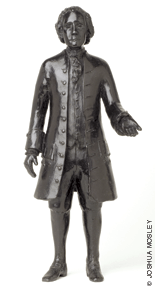
The 52nd International Art Exhibition of the Venice Biennale opened in the venerable Venetian Arsenal and the city’s Public Gardens last month, and among the roughly 100 artists represented is Dr. Joshua Mosley, associate professor of fine-arts animation at Penn. His installation, “dread,” consists of a mixed-media animation film in one room of the Gardens’ Italian Pavilion and five bronze sculptures in another room.

In the animation, the philosophers Jean-Jacques Rousseau and Blaise Pascal “look at nature, meet each other, share ideas, take a walk, and finally Rousseau is eaten by a large dog,” explains Mosley in an email from Rome, where he has been a fellow at the American Academy for most of the past year. The project, which has taken some 32 months to complete, began with a drawing of a three-headed dog that he did in Philadelphia.
“Two of the heads were speaking; one looked like it was saying Pascal, the other looked like it was saying Rousseau, and so I wrote the words next to their mouths,” Mosley recalls. “I roughly knew that they had dealt with ideas that I was interested in thinking about in a contemporary context, so I began reading [Rousseau’s] Emile and [Pascal’s] Pensées, and also went to Van Pelt [Library] to read more and think about how each connected to the world at present and how they might come together.”
The title of the installation comes from the name of the canine subject of Eadweard Muybridge’s “Animal Locomotion” series in the mid-1880s.

“I modeled the dog in clay after the photograph of the walking mastiff that Muybridge photographed on our campus,” says Mosley. “‘Dread’ became the name of the bronze sculpture, the name of the animation, and eventually the title of the overall project.
“I wanted a title that expressed the activity of almost trying to see into the depth of nature,” he adds. “Doing this, we would be somewhat fearful of disorienting our sense of self, disconnecting with our soul, or distancing our god—assuming we believed in one. Not going forward with looking at nature closely, we would risk not seeing it fully.”
By the time he wrote that email in May, Mosley had been in Rome for nine months, finishing the animation, writing the dialogue, and reworking the music—which he composed, despite the fact that he has no formal musical training. (He can read music, though, and does have experience working with animated-film composers, including Paul Richards, the composer of Dr. Wendy Steiner’s The Loathly Lady [“The Wife, The Lady, and the Book of Dames,” March|April].) With the help of Brendan Marnell C’05, a former animation student, Mosley spent four months rigging the 3D scans for animation.
Finishing the project in Italy has had “several effects,” he says. “Since the subject relates to questions of existence, and my studio is only six blocks from the Vatican and next door to the U.S. Ambassador to the Holy See, I’ve felt more aggressive about the way that I connect the difficulty of vision with religion in the animation. I have also been able to test-screen the animation for dozens of curators and artists at the American Academy in Rome, so the process has been more public than usual.”
Though Mosley originally thought he would create a synthetic computer-generated forest for the film, one walk in the real forest convinced him that a computer-generated landscape “completely underestimates the complexity of what is really happening in the forest,” he admits. “Some people understand computer algorithms, but nobody understands the forest.”—S.H.




